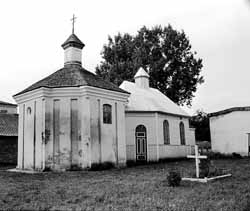“Three Hundred Captive Maidens Died A t Lokachi”

In the late 1950s, locks of young female hair were unearthed during construction work at Lokachi, a district town in Volyn oblast. The site is marked by a small chapel as an historical symbol of Lokachi (no one knows exactly when it was built and at whose expense).
One learns from the historical sources that no time or purpose is ever mentioned anywhere, nor, in fact, is the chapel itself. This might be because local historians have had no access to the right archives. There is a romantic legend, however, handed down by generations at Lokachi. It says that the chapel was built where three hundred girls from Volyn had been buried in 1241, after being captured by Tartars and then slain as Volyn forces advanced.
Another story holds that the girls died because they refused to put up with captivity; one of them attacked the Tartar officer in command of the detail escorting them (or perhaps even the Tatar khan!) and strangled him. It is an historically established fact that Burundai’s troops besieged Volodymyr (currently Volodymyr-Volynsky), so they could not have possibly bypassed Lokachi. Other legends say the name of the village, Stary Zahoriv (not far from Lokachi) also dates from “the Tartar times, that the sentinel atop the watchtower by the entrance to the village noticed the enemy too late, so he set fire to the tower to warn the villagers and died in the fire.”
And there were locks of girls’ hair, many of them, unearthed on the site at different periods. Zinayida Teseniuk, Meritorious Teacher, historian, and author of numerous papers on local history, was told about them by her father. He was a construction team leader and they were digging a trench for what would become the premises of the local cooperative society. They found locks of hair, a rather chilling reminder of events long since forgotten. This hair was buried by the chapel, along with human remains also found in the vicinity.
* * *
Life in places like Lokachi passes close to the axis of history, running like sand through one’s fingers. Some grains of this sand, however, settle on the pages of annals, often proving unique information. To begin with, Lokachi was visited by Saint Volodymyr, the prince that baptized Kyiv Rus’, following a large horse-trodden route leading to the Volyn city that would bear his name. Polish chroniclers maintain that Lokachi originates from the Slavic verb lokaty, to feed horses en route. Many other local place names are associated with the road: Korytnytsia [from koryto, trough] where they must have also fed horses; Kolpytova [from kopyto, hoof] where they had their hooves cleaned; and Koniukhy [from koniukh, groom) where they must have changed grooms.
There was even a castle at Lokachi (the rampart and the name of the neighborhood, Podzamche {Castletowm} are all that remains). Zinayida Teseniuk read in a Polish chronicle that in 1787 Stanislaw II Augustus [also called Stanislaw Poniatowski (1732-1798), last king of Poland (1764-1795)] visited with a local landlord on his way to Poland from Kyiv; the castle was already ruined, so the landlord received the king at his estate in Lokachi.
The western fringe of Lokachi has long been popularly known as Selyske [Small Village], a scenic locality surrounded by the river and a very convenient habitat. Could this explain the name? The town is officially over 600 years old, but local school students are known to have unearthed needles and distaffs made from bone dating back more than a thousand years. Lokachi teems with legends, and one has it that many centuries ago there was a church that was suddenly and inexplicably swallowed up by the earth, replaced by a small lake, very deep and hard to get to. Indeed, the territory of the town is rich in underground passages.
Another legend says that the local castle was inhabited by an ill- tempered, cruel woman; she treated her people ruthlessly and would visit the town riding on a cart driven by a trained pig. And there truly is a Polish document dating from 1696, reading that a certain Zigmund Augustus brought suit against a certain Anna Sanguszko, owner of Lokachi, who was “levying unbearable taxes.” Perhaps some information might also be unearthed about that trained pig, muses Mrs. Teseniuk.
Our visit to Lokachi coincided with an important Orthodox autumn al holiday. Several years ago, the old chapel started a new life. For several generations all the people of Lokachi had considered it a sacred place. Many still have in their home archives the poem by Hryhory Pechenivsky of Lviv, with the opening line reading “three hundred captive maidens died at Lokachi...” Zinayida Teseniuk (she retired not long ago) remembers that divine services were celebrated on every holiday and many candles were lit. The chapel was tended by Mariya Zaida, former high school student who also recited prayers. Mrs. Teseniuk describes here as a woman possessed
The chapel survived the Napoleonic Wars (in 1812 a pitched battle lasted two days nearby), two world wars, and then it fell pray to Communist antireligious campaigners. Local Soviet authorities used the premises as a gasoline storage facility and later to store old films. In 1977, the roof caved in, but the walls remained, thick, made of large bricks, each bearing three Latin characters. The roof fell at night and Zinayida Teseniuk learned the bad news the next morning on her way to school. That day she could hardly bring herself to step into her class... She wrote countless letters requesting restoration, but none of the Soviet “societies for the preservation of historical monuments” responded.
Restoration was done in 1994 on the local state administration’s initiative. Eventually, the local Orthodox community attached a temporary wood structure to the chapel, now serving as the altar, in place of the Church of the Transfiguration (also ruined in the 1970s). The so-called Maiden Chapel had been part of it and the scene of the khresny khid processions with the cross.
There is also the Church of St. Nicholas at Lokachi, built in 1911- 13, commemorating the Romanov dynasty’s tercentennial. It is located in the part of the town known as Uima Lokatska, the name of a large village described as Bily Khutir by Marharyta Malynovska, a gifted Ukrainian writer, also of Uima and destined to part with this world so early, in her novel Thunder Lakes. The church survived Communist atheistic pogroms largely owing to the Rev. Oleksandr Voitiuk (God rest his soul). The parishioners revere his memory, yet now (considering that God acts in mysterious ways) the adherents are divided by patriarchates, so that St. Nicholas’ currently belongs to the Moscow patriarchate and Transfiguration to Kyiv... Lokachi residents often disregard this division and attend services at the church attended by their ancestors, the one closest to their homes. Both churches are small in size.
The structure attached to the Maiden Chapel is too small to accommodate all of the faithful, so the local Kyiv patriarchate community is planning a large and complicated project; the old structure will not be renovated, this being too consuming of time and money, but a new house of God will be erected, bearing the same name, Transfiguration.
“People attending divine services to mark important religious holidays have to stay outside the church — and believers come from not only from Lokachi, but also from neighboring villages: Kurkhynychi, Khory, Kozly, and Bermeshy. People freeze outside the temple on Christmas Eve, unable to hear The Word in their mother tongue, in their church. This is intolerable!” say parishioners.
They hope for other people’s help, those that really care about the spirituality of their native land.
P.S.:
A project of the Transfiguration Church in Lokachi is ready, and it is time to buy bricks. The local religious community will appreciate donations to Account #26003237211001, Lokachi Office, Novovolynska Branch of Privatbank, MFO 303406, Code 21736627, C/O “Cathedral of the Transfiguration.”






